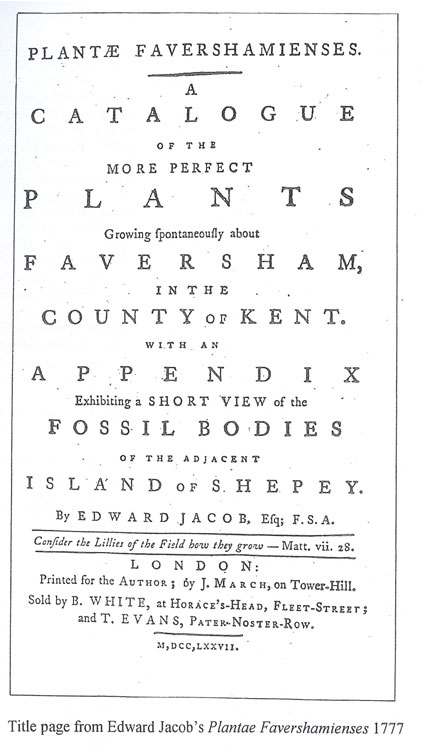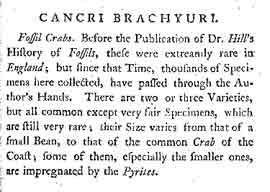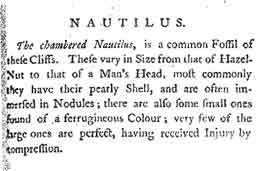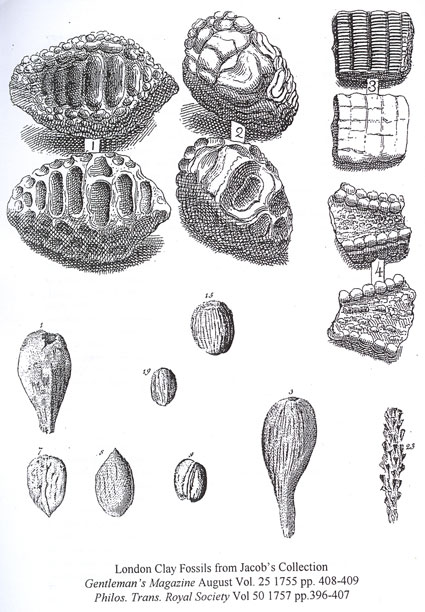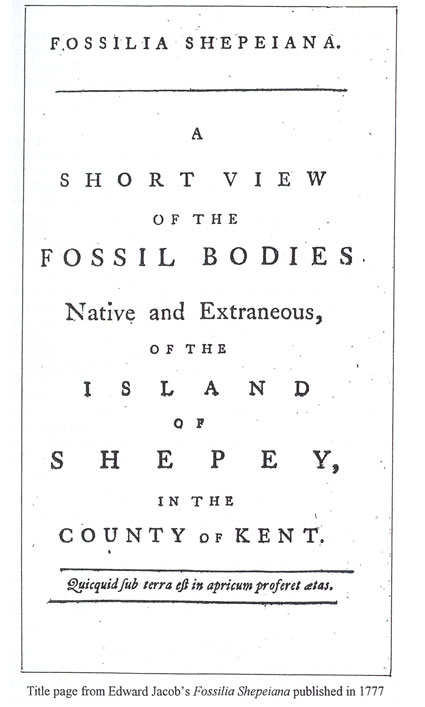It was, however, very little known until the Georgian era that the Isle of Sheppey was a veritable paradise, and a happy hunting-ground for the antiquarian, the naturalist, the geologist and the zoologist. It was thanks to Edward Jacob, Esquire, F.R.S., who acquired the little Manor of Nutts, in Sheppey, that this important discovery was made. In A.D. 1752, Mr. Jacob purchased this pretty little estate and came to reside here, and, in the course of his explorations of the island, he soon recognised that it afforded a fine field for profitable research, and for satisfying his pet hobby. The Jacob family had resided in Kent for many generations, and our scientific hero was the son of Mr. Alderman Edward Jacob, of Canterbury, who held the office of Chamberlain of that city. Mr. Edward Jacob, of Nutts Manor, had long been a member of the Antiquarian Society, and was afterwards long remembered as both a skilled antiquarian and a learned naturalist. He wrote many works on these interesting subjects, the principal of which are "Fossilia Shepeiana, or Fossil Bodies, Native and Extraneous, of the Island of Sheppey," "Plantae Favershamienses," and the "History of Faversham. " In the former of these works the learned author says: "Sheppey hath long been noted for producing large quantities of Sheep (whence probably its name is derived) as well as Corn; and exhibits to the Curious Naturalist a most desirable Spot, by affording many rare Plants, and more especially in the of its Northern Cliffs, so great a Quantity and Variety of Fossils, both native and extraneous are scarcely to be paralleled. These Cliffs length about six miles; Minster, Shurland and Warden are the Manors to which they appertain, the more elevated parts whereof reach about thirds of their extension, and are at the very highest of them not less than fifty yards perpendicular height above the Beach and Shore."
Making a general survey of his many discoveries in the Isle of Sheppey, concludes by saying that "From the con of so great a variety of extraneous Fossils in these Cliffs, which were evidently the very different Climates, he thinks himself induced to believe that nothing short of a Deluge could be a Cause adequate t Effect." It is impossible for us to devote space to catalogue the scores of rare plants and fossil which Mr. Jacob so learnedly discourses upon a indigenous to the soil of Sheppey, the name alone fill fifty pages in Mr. Jacob's work Fossilia Shepeiana". It was in the year A.D.1750 that he discovered the acelabultim, one of the spinal vertebrae and a thigh bone four feet long of an elephant sticking in the clay on the Minster cliffs, together with many other fragments of this huge animal but unfortunately they were all too rotten to be taken up entire. After this he found, on his own Manor, Nutts, in Sheppey, an elephant's tusk, an as to outward appearance it lay entire he took it dimensions, which were eight feet long and twelve inches in circumference in the middle. This prodigious specimen of the Elephas, unfortunately, fel to pieces, after having been raised out of the ground and exposed to the' atmosphere. He also found part of a Scahula,, itsflizus almost entire, three inches in diameter, and many portions of grinders.
Speaking of the elephant above alluded to, Mr Jacob says: "A considerable number of Bones of this very large animal, have been discovers on the Eastern Shore, a Mile from the Cliffs, o the Author's Manor of Nutts, in Sheppey, a account of which may be seen in the Philosophical Transactions, vol. xlviii., part ii., page 626.' The author proceeds to describe no less that thirty-four different varieties of animal fossil remains, innumerable specimens of rare fossi fruits and vegetables, together with many beautiful examples of old-world animal and piscatoria petrification, including the turtle and nautilus Mr. Jacob declares that ' the Chambered Nautilus is a common Fossil of these Cliffs. These vary in size from that of a Hazel-nut to that of a Man' Head, and are often immersed in Nodules; there are also some small ones found of a ferruginous Colour; very few of the large ones are perfect having received Injury by Compression."'
"Timorous readers, however, need entertain no feverish fear, on, visiting the Isle of Sheppey, of encountering either wild elephants, crocodiles, sharks, serpents, or man-eating birds of huge dimensions, bearing strange names, and armed with sets of teeth for masticating and digestive purposes, as the author can assure them that they all died out a million or so of years ago, before he undertook to look up their records and write the history of this wonderful little island. Visitors may, however, honestly deplore the absence of the feathery palm trees bearing the luscious date and the lacteous cocoa-nut; but by prosecuting a diligent search they may, at least, be consoled by procuring some of these, rare fossil remains, reminiscent of an incalculable period of time when our particular portion of this hemisphere performed its diurnal revolutions in the immediate zone of the tropics." |

